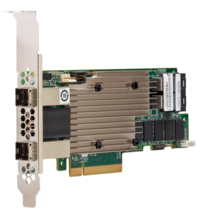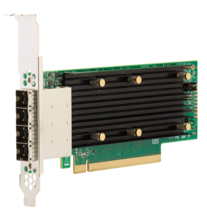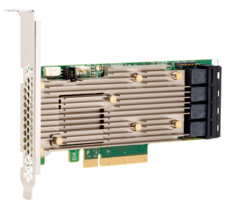Broadcom Server Storage HBA and MegaRAID Solutions With SFF-TA-1001 (U.3) Reference Platform
U.3 standard defines common bay type and connector for SAS, SATA, and NVMe devices.
This is a Press Release edited by StorageNewsletter.com on November 17, 2017 at 2:35 pmBroadcom Limited announced the availability of a Server Reference Platform in support of the SFF-TA-1001 specification commonly known as U.3.
MegaRAID 9480-8i8e

The U.3 standard defines a common bay type and connector for SAS, SATA, and NVMe devices. The creation of the U.3 standard gives flexibility to system OEMs and data centers that want to support the latest storage technologies at the lowest cost and system complexity. The availability of this server reference platform will enable server and storage OEMs, drive manufacturers, and cable and connector suppliers to design and deploy systems based on U.3. The firm’s already shipping family of NVMe/SAS/SATA Tri-Mode SerDes MegaRAID and HBA controllers are a technology to enable this standard.
HBA 9405W-16e Tri-Mode

“We are excited to bring together such a broad community of storage leaders to accelerate the adoption of U.3 into the Server. Our Tri-Mode SerDes technology, which we pioneered in our latest generation of storage adapters, is fundamental to enabling U.3,” said Jas Tremblay, VP and GM, data center solutions group, Broadcom.
The company’s Data Center Solutions Group (DCSG) has a long history of storage innovations that have continually delivered both simplifications to the storage infrastructure and flexibility, while delivering a performance and functionality. Over the years, the firm has been involved in every generation of parallel and serial SCSI, was the first to introduce SAS, and introduced a SATA translation layer which allowed low-cost SATA to be used in the enterprise SAS domain. In the current generation of storage controllers, the company pioneered the concept of a Tri-Mode device interface which enables system designers the flexibility of using a single controller for SAS, SATA, and NVMe storage options.
In collaboration with Hewlett Packard Enterprise, the company authored the U.3 specification which defines a common backplane bay type for SAS, SATA, and NVMe.
“As a co-developer of the U.3 specification with Broadcom, HPE is pleased to see it become an industry standard. This innovation is a part of our mission to provide a new compute experience to our customers by simplifying server operations. More directly, U.3 streamlines server-based storage and enables drive bay flexibility,” said Tom Lattin, VP and GM, mass market platforms, options and software, Hewlett Packard Enterprise Development LP (HPE).
Together with the firm’s NVMe/SAS/SATA Tri-Mode SerDes MegaRAID and HBA controllers, this creates a foundation for a more simplified storage infrastructure and reduces the cost of bringing NVMe into entry-level server storage.
U.3 allows SAS and SATA HDDs and SAS, SATA, and NVMe SSDs to operate in a single bay without the complexity of wiring for multiple protocols. It enables single, dual, and wide-port SAS, SATA, and x1, x2 or x4 NVMe devices to all work on the same shared signals and connectors. U.3 devices use the same mechanicals and are backwards compatible with the U.2 or SFF-8639 specification. U.3 is driven out of SNIA SFF Technology Affiliate (TA) Technical Work Group (TWG). The specification is identified as SFF-TA-1001, ‘Specification for Universal x4 Link Definition for SFF-8639‘.
MegaRAID 9460-16i

As an emerging standard, U.3 is finding support from variety of server and storage OEMs, large data centers and drive vendors.
Key benefits of U.3 for these users are:
-
Preserves existing investments in SAS/SATA infrastructure while enabling emerging NVMe SSDs to leverage the same infrastructure
-
Reduces storage subsystem and backplane complexity and cost to support the same level of interchangeability
-
Simplifies server or storage SKUs for both OEMs and end-customers; customers no longer have to buy SAS/SATA or NVMe-specific chassis or pre-configure for HDD vs SSD
The reference platform includes the company’s already shipping NVMe/SAS/SATA Tri-Mode SerDes MegaRAID and HBA family of controllers, a U.3 backplane reference schematic, Universal Backplane Management (UBM) specification, a virtual SES implementation for direct-connected devices, demo and validation platform and SFF-9402 compliant cables.
Using the U.3 reference platform enables server and storage OEMs to quickly develop scalable backplanes with less complexity and cost for current and next generation storage solutions. Systems gain the flexibility of interchanging drive types with a single U.3/SFF-TA-1001 bay. Furthermore, SFF-9402 based cables and connectors allow common translation between connector types (SlimPCIe/SlimSAS, OCuLink/MiniLink and Mini SAS HD) simplifying the ecosystem and reducing cost of solutions designed around the U.3 specification.
For SSD drive vendors, the firm’s Data Controller Division (DCD) which designs custom SSD and HDD Controllers has SERDES and muxing IP to support U.3 SSD Controllers. This IP enables SSD vendors to design controllers to easily support the emerging U.3 standard.
Industry server, drive and connector providers support the company’s U.3 initiative. The firm is working with OEMs and numerous ecosystem partners to provide a collaborative standard that will enable customers to build flexible systems across a range of applications and industries.
The Tri-Mode family of performance 12Gb/s NVMe/SAS/SATA MegaRAID solutions are available.
“The Foxconn Interconnect Technology (FIT) U.3 connector, featuring a high-speed design, supporting up to 24Gb/s and is backward compatible to NVMe, SAS and SATA will allow system builders and data center customers to build flexible, low-cost server solutions,” said Joseph Wang, CTO, Foxconn Interconnect Technology (FIT). “The adoption of the U.3 standard will enable broader compatibility within the ecosystem, including motherboards and HDDs, increases attach rates and reduces limitations.“
“Fujitsu Server Primergy systems are known for their modular designs. On top of their powerful performance and efficiency, the next-generation servers are optimized with a rich feature set to suit the broadest range of application scenarios across a range of industries. Adoption of the U.3 standard and the Broadcom Tri-Mode SerDes reference platform, for common bay type and connector, widens system configuration options for customers, while delivering exceptional performance, scalability, and expandability,” said Armin Kumpf, head, server R&D, EMEIA, Fujitsu Ltd.
“Huawei is looking forward to the continued evolution of storage standard to drive performance, simplicity and robustness,” said Qiu Long, GM, server product line, Huawei Technologies Co., Ltd. “The Broadcom U.3 reference platform has enabled Huawei to accelerate the development of our next generation servers and help with the flash transition.“
“Inventec is committed to providing storage connection innovation and options for our hyperscale and OEM data center customers,” said Jack Tsai, president, enterprise business group, Inventec Corp. “This new connector standard helps our customer transition from SATA to NVMe connectivity as flash continues to grow in importance. We continue to collaboration closely with Broadcom and applaud their leadership and innovation in storage connectivity.“
“Our customers need performance, flexibility and simplicity as we need to support SATA, SAS and NVMe drives in storage systems. StackVelocity (Jabil’s cloud focused business unit) is utilizing Broadcom’s Tri-Mode technology as a key building block for its new storage systems. The U.3 standard will help complement this,” said Sherman Tang, CTO, compute and storage, Jabil, Inc. “The benefits of reduced complexity and preservation of existing infrastructure will be key to the expansive ecosystem.“
“Micron is focusing technical assets and research efforts on future standards that will facilitate the integration of emerging technologies, such as NVMe, with traditional SAS/SATA infrastructures,” said Currie Munce, VP, SSD engineering, Micron Technology, Inc. “We are always looking for ways to collaborate with our ecosystem companies to solve customer problems and develop relevant products for the marketplace.“
“Molex has actively participated in the standardization effort of U.3 and sees great potential to further expand the NVMe and PCIe infrastructure for storage applications. We look forward to working with Broadcom and other members of the industry to accelerate the deployment of U.3 based infrastructure,” said Jay Neer, manager, industry standards, Molex, Inc.
“The new U.3 connector standard will better enable our customers to build the mission-critical applications their high-performance data center solutions require,” said Mike Yang, president, QCT (Quanta Cloud Technology, company’s parent of Quanta Computer, Inc.). “The flexibility and reduced complexity of the U.3 standard allows us to be competitive in this ever-changing market.“
“Rackspace supports a variety of multi-cloud infrastructure for customers around the world,” said Adi Gangidi, systems design engineer, Rackspace US, Inc. “The U.3 standard will help us provide more value to customers through added flexibility to compute infrastructure and servers. This will allow us to more effectively standardize our equipment and better accommodate a variety of storage media at reduced cost. We are excited to adopt this reference platform as it will benefit not only Rackspace but the industry at large.“
“As a leader in SSD technology, Samsung is trying to provide Industry standard product, which will support SAS, SATA and NVMe with a common design for Enterprise Server Storage customers,” said ChanIk Park, VP, NAND memory planning/enabling group, Samsung.
“Seagate continues to deliver flash drive innovation in Enterprise and Datacenter SSDs. The adoption of the new U.3 standard enables our customers to reduce complexity and cost of managing massive storage infrastructures and in navigating the transitions between protocols,” said JB Baker, senior director, SSD product management, Seagate Technology plc. “U.3 has the potential to deliver a new level of flexibility in deploying a variety of drive topologies to address end-users’ needs.“
“Working with storage industry leaders like Broadcom to support the U.3 standard further enables the server flexibility that our customers require,” said Charles Liang, founder, president, CEO and COB, Super Micro Computer, Inc. “The U.3 standard will expand opportunities within the storage ecosystem, across all building blocks, allowing our customers to address all of their growing data center needs.“
“We appreciate Broadcom’s innovative spirit and technical development on enabling the Tri-Mode PHY and common socket ecosystem for SATA, SAS and NVMe PCIe drives,” said Jeremy Werner, VP, SSD marketing and product planning, Toshiba Memory America, Inc. “Customers who deploy U.3 bays in future platforms will have more flexibility to choose the right Toshiba SSD for their application, whether it is SATA, SAS or NVMe, and also may be able to take advantage of the better performance of MultiLink SAS without additional expense in a socket which enables a 4-lane PCIe SSD.“













 Subscribe to our free daily newsletter
Subscribe to our free daily newsletter

